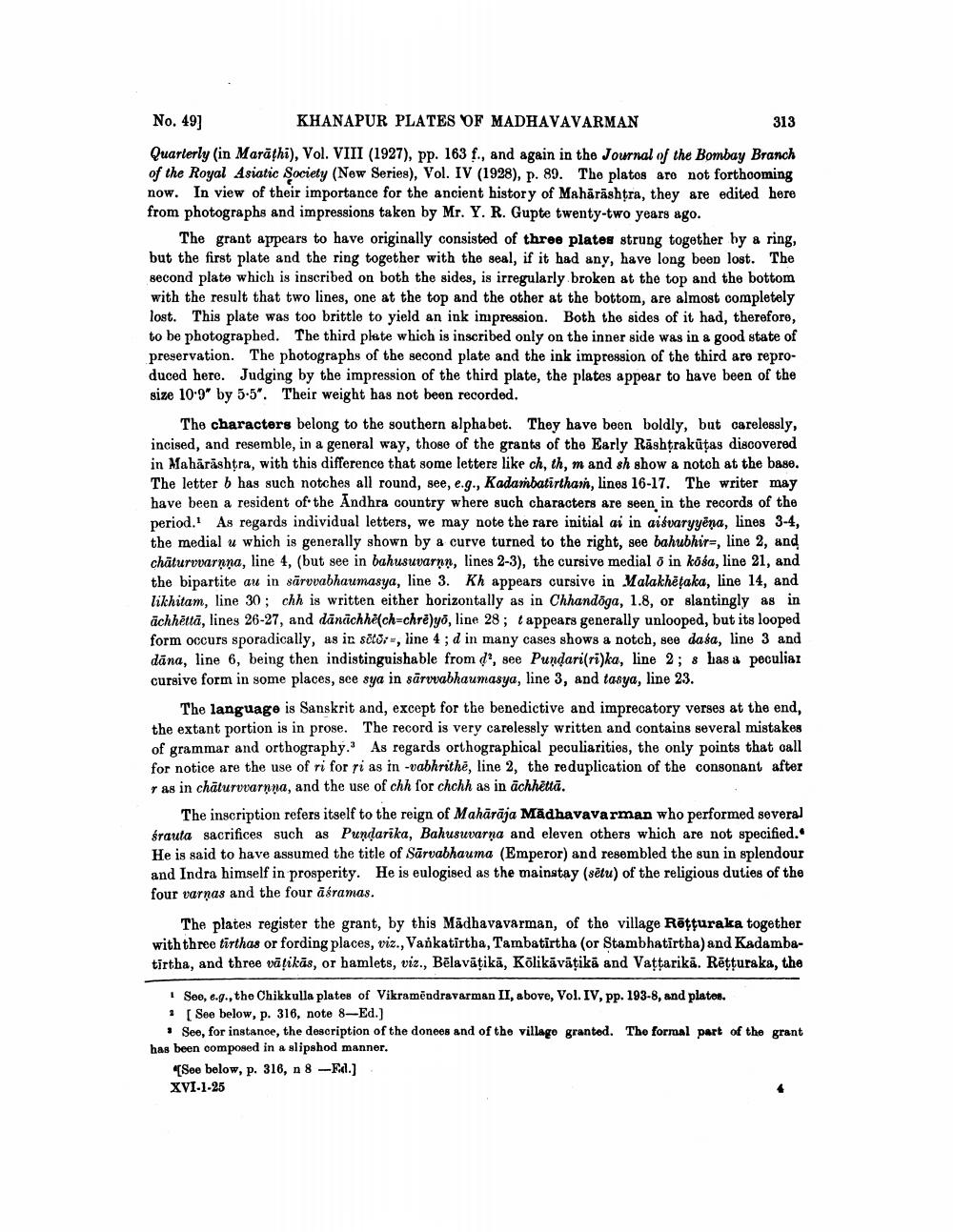________________
No. 49] KHANAPUR PLATES OF MADHAVAVARMAN
313 Quarterly (in Marathi), Vol. VIII (1927), pp. 163 f., and again in the Journal of the Bombay Branch of the Royal Asiatic Society (New Series), Vol. IV (1928), p. 89. The platos are not forthooming now. In view of their importance for the ancient history of Maharashtra, they are edited here from photographs and impressions taken by Mr. Y. R. Gupte twenty-two years ago.
The grant appears to have originally consisted of three plates strung together by a ring, but the first plate and the ring together with the seal, if it had any, have long been lost. The second plate which is inscribed on both the sides, is irregularly broken at the top and the bottom with the result that two lines, one at the top and the other at the bottom, are almost completely lost. This plate was too brittle to yield an ink impression. Both the sides of it had, therefore, to be photographed. The third plate which is inscribed only on the inner side was in a good state of preservation. The photographs of the second plate and the ink impression of the third are reproduced here. Judging by the impression of the third plate, the plates appear to have been of the size 10.9" by 5.5". Their weight has not been recorded.
The characters belong to the southern alphabet. They have been boldly, but carelessly, incised, and resemble, in a general way, those of the grants of the Early Rashtrakūtas discovered in Maharashtra, with this difference that some lettere like ch, th, m and sh show a notch at the base. The letter b has such notches all round, see, e.g., Kadambatirtharn, lines 16-17. The writer may have been a resident of the Andhra country where such characters are seen in the records of the period. As regards individual letters, we may note the rare initial ai in aišvaryyêna, lines 3-4, the medial u which is generally shown by a curve turned to the right, see bahubhir, line 2, and châturvvarnna, line 4, (but see in bahusuvarnn, lines 2-3), the cursive medial o in koša, line 21, and the bipartite au in sāruvabhaumasya, line 3. Kh appears cursive in Malakhețaka, line 14, and likhitam, line 30; chh is written either horizontally as in Chhandöga, 1.8, or slantingly as in āchhēttā, lines 26-27, and dānachhë(ch=chre)yo, line 28; t appears generally unlooped, but its looped form occurs sporadically, as in stor, line 4;d in many cases shows a notch, see daśa, line 3 and dāna, line 6, being then indistinguishable from d', see Pundari(ri)ka, line 2; & las & peculiar cursive form in some places, see sya in sārvabhaumasya, line 3, and tasya, line 23.
The language is Sanskrit and, except for the benedictive and imprecatory verses at the end, the extant portion is in prose. The record is very carelessly written and contains several mistakes of grammar and orthography. As regards orthographical peculiarities, the only points that call for notice are the use of ri for ri as in -vabhrithē, line 2, the reduplication of the consonant after ras in chäturvvarnna, and the use of chh for chchh as in achhëltā.
The inscription refers itself to the reign of Mahārāja Mādhavavarman who performed several śrauta sacrifices such as Pundarika, Bahusuvarna and eleven others which are not specified. He is said to have assumed the title of Sārvabhauma (Emperor) and resembled the sun in splendour and Indra himself in prosperity. He is eulogised as the mainstay (setu) of the religious duties of the four varnas and the four asramas.
The plates register the grant, by this Mādhavavarman, of the village Rēţturaka together with three tirthas or fording places, viz., Vaňkatirtha, Tambatirtha (or Stambhatirtha) and Kadambatirtha, and three vā tikās, or hamlets, viz., Bēlavăţikā, Kõlikāvātikā and Vaţtarikā. Rēţturaka, the
i Seo, e.g., the Chikkulla plates of Vikramendravarman II, above, Vol. IV, pp. 193-8, and plates. · [See below, p. 316, note 8-Ed.)
• See, for instance, the description of the donees and of the village granted. The formal part of the grant has been composed in a slipshod manner.
[See below, p. 316, n 8-Ed.) XVI-1-25




